|
The genus Orbea includes around 56 species of leafless stem succulents forming clumps and mats of vegetation. The green stems are four-angled with prominent pointed tubercles and may develop attractive purple blotching in bright sunlight. Stems generally branch from their base.
Orbea have unusual five-lobed flowers, generally with a raised ring or annulus around the centre. This ring (Latin: orbis = ring) accounts for the name of the genus. The flowers of many, but not all species produce a putrid odour of rotting carrion to attract blow flies as pollinators. The petal edges of some species carry numerous hairs that vibrate with the slghtest air motion. This flickering is thought to attract pollinators. As with other Asclepiads, pollen is contained in pollinaria which must be transferred to the female part of the flower by the pollinator. Following fertilisation of flowers, pairs of seed horns appear containing many seeds, each with its own silken parachute.
For many years Orbea was merged with Stapelia until separation by Leach (1975). The genus has been much revised, with several species recently incorporated from Stapelia, Caralluma, Diplocyatha, Orbeopsis, Orbeanthus and Stultitia to Orbea. Names on labels have often not caught up with these changes. The genus is distributed throughout Africa and into Arabia. Orbea variegata is regarded as an exotic invasive species in S. Australia.
|
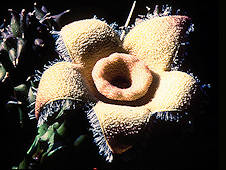
Orbea ciliata (Thunberg) L.C. Leach 1975
Syn. Diplocyatha ciliata (Thunberg) N.E. Brown 1878
This succulent asclepiad has dark green stems with very prominent tubercles. It produces attractive off-white odourless flowers about 7.5 cm in diameter.
Native to the South African Karoo. The clone in cultivation in the UK exhibits a degree of monstrose growth.
It is relatively easy to grow and propagate and quite free-flowering, but likes to be kept warm. However, in 1996 plants kept absolutely dry survived in a cold-frame through an exceptionally cold UK winter. The fringe of hairs on each petal is disturbed by the slightest air currents and is almost always in motion.
|
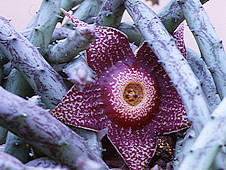
Orbea hardyi (R.A. Dyer) Bruyns 2000
Syn. Stultitia hardyi R.A. Dyer 1963
The smooth brittle stems become attractively marbled with purple in a strong light and have a few widely-spread tubercles. The attractive (but smelly) maroon flowers flecked with yellow, about 3in in diameter, generally open facing down on my plant and are therefore hard to photograph - except for this one.
 Native to the South African Transvaal. Stems tend to break at the joints. Hence when repotting, it is difficult to preserve a large plant intact and one tends to end up with a handful of cuttings. In any case the stems tend to elongate and grow out of their pot, so a good specimen plant is a challenge.
Native to the South African Transvaal. Stems tend to break at the joints. Hence when repotting, it is difficult to preserve a large plant intact and one tends to end up with a handful of cuttings. In any case the stems tend to elongate and grow out of their pot, so a good specimen plant is a challenge.
|
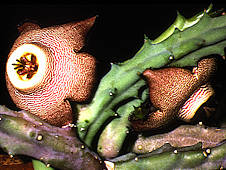
Orbea pulchella (Masson) L.C. Leach 1975
The tuberculate stems form mats. Flowers are yellowish flecked orlined with varying amounts of chocolate brown and smelling of carrion.
Native to a limited area around Port Elizabeth in the Eastern Cape of South Africa, growing in coastal sand dunes and sandy flats.
|
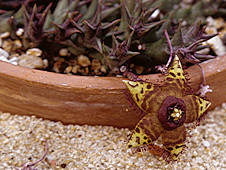
Orbea senota (N.E. Brown) L.C. Leach 1975
The tuberculate stems form mats, rooting as they touch the ground. The large foul-smelling, 5-lobed flowers may be chocolate brown, pure yellow or mottled with varying amounts of both colours. Flower lobes are fringed with dark hairs that are always in motion.
Native to Kenya, Rwanda and Tanzania.
|
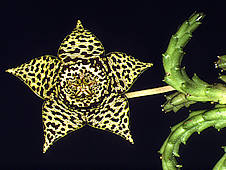
Orbea variegata (Linnaeus) Haworth 1812 (Starfish Flower)
Syn. Stapelia variegata Linnaeus 1753
Name: Latin variegatus = "being different colours"
 This variable plant has dark green tuberculate branching stems that begin erect but become prostrate as they elongate. The large 3in flowers have 5 lobes with varying degrees of yellow and brown to purple mottling. They produce the smell of a dead animal to attract blow flies. This variable plant has dark green tuberculate branching stems that begin erect but become prostrate as they elongate. The large 3in flowers have 5 lobes with varying degrees of yellow and brown to purple mottling. They produce the smell of a dead animal to attract blow flies.
Native to South Africa. This is probably the most common Stapeliad in cultivation, having reached Europe in 1639. It is very tolerant, easy to grow and ideal for beginners with a sunny window ledge.
|

 Families of Succulent Plants
Families of Succulent Plants 








 Native to the South African Transvaal. Stems tend to break at the joints. Hence when repotting, it is difficult to preserve a large plant intact and one tends to end up with a handful of cuttings. In any case the stems tend to elongate and grow out of their pot, so a good specimen plant is a challenge.
Native to the South African Transvaal. Stems tend to break at the joints. Hence when repotting, it is difficult to preserve a large plant intact and one tends to end up with a handful of cuttings. In any case the stems tend to elongate and grow out of their pot, so a good specimen plant is a challenge.
 This variable plant has dark green tuberculate branching stems that begin erect but become prostrate as they elongate. The large 3in flowers have 5 lobes with varying degrees of yellow and brown to purple mottling. They produce the smell of a dead animal to attract blow flies.
This variable plant has dark green tuberculate branching stems that begin erect but become prostrate as they elongate. The large 3in flowers have 5 lobes with varying degrees of yellow and brown to purple mottling. They produce the smell of a dead animal to attract blow flies.


